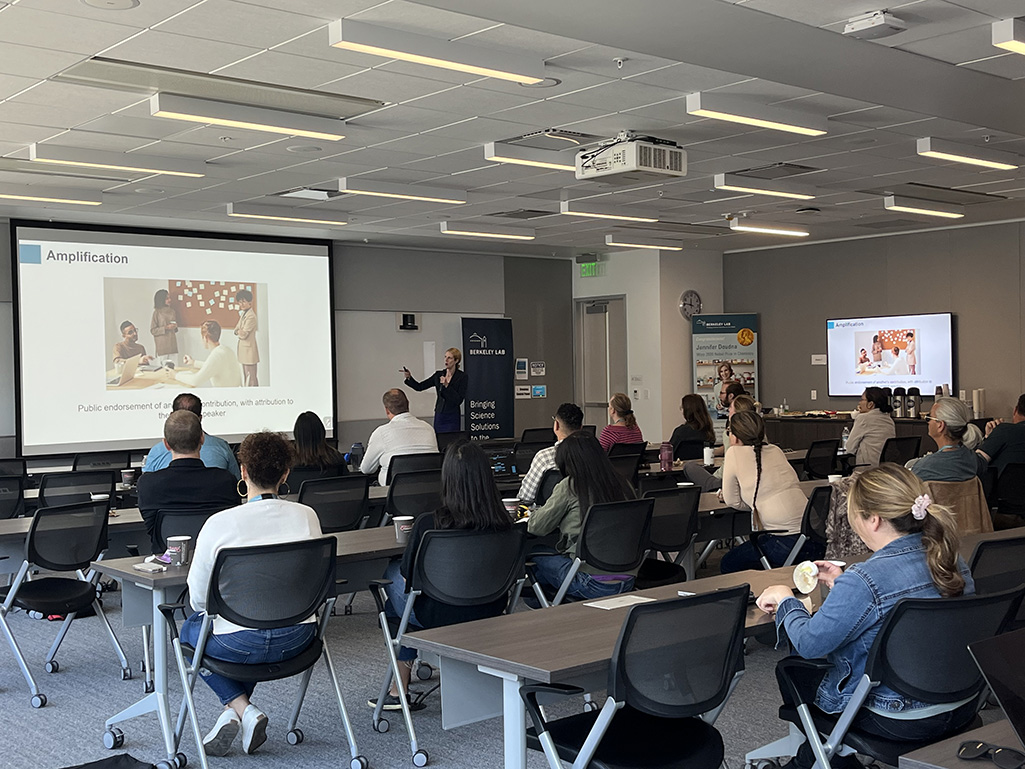As workplaces evolve to include Generation Z—the cohort born between 1997 and 2012 and the first true digital natives—organizations are uncovering both challenges and exciting opportunities in communication. Generation Z’s deep connection with technology, social media, and rapid information exchange influences everything from collaboration to feedback styles. Understanding and adapting to these shifts is essential for creating a productive, connected, and innovative work environment.
In June, Juliana Schroeder, the Harold Furst Chair in Management Philosophy and Values and an associate professor in the Management of Organizations group at the Haas School of Business at the University of California, Berkeley, delivered an insightful and thought-provoking seminar titled “Successful Communication at Work: New and Evergreen Principles with Gen Z.” Hosted by ATAP’s Stewardship, Outreach, & Culture committee, in partnership with Berkeley Lab’s Employee Resources Group and Women’s Support and Empowerment Council, the well-attended in-person event brought together employees from multiple generations and sparked an engaging discussion on how communication is evolving as Gen Z enters the workforce.
The Foundations of Good Communication
At its core, effective workplace communication is about making sure that the message is received and understood as the sender intended. This is especially important when bridging generational gaps. Gen Z employees, who have grown up with instant messaging, video calls, and collaborative online platforms, often expect clear, concise, and interactive communication. This can emphasize transparency, inclusivity, and quick feedback.

Schroeder points out that successful intergenerational communication occurs “when the receiver ends up with the same understanding of the thought articulated by the sender, there is a good relationship between them, and there is value added to the thought.” With many in Gen Z and other generations, this often means adapting to their preference for directness, digital communication, and a collaborative approach.
Key Phrases for Effective Communication
To bridge generational gaps and promote clarity, Schroeder suggests using phrases that encourage conversation and demonstrate active involvement. These could be particularly effective with Gen Z and are good practices for everyone.
- Clarification: “Can you elaborate on that point?” “To clarify, are you saying…?”
- Confirmation: “So, if I understand correctly …” “Just to confirm, we’re agreed on …”
- Empathy: “I understand your concern about …” “I can see why you feel that way.”
- Collaboration: “Let’s brainstorm some solutions together.” “What are your thoughts on this?”
- Feedback Solicitation: “What’s your feedback on this proposal?” “How can I improve this?”
Strategies for Better Communication Across Generations
For many in Gen Z, communication style is shaped by digital skills and a desire for authentic, two-way interactions. Schroeder suggests several strategies to meet these expectations:
- Active Listening: Go beyond hearing words—pay attention to both verbal and nonverbal cues, ask clarifying questions, and summarize messages to ensure a clear understanding. Employees appreciate when their voices are heard and valued.
- Clear and Concise Messaging: Avoid jargon and unnecessary complexity. Straightforward communication, often preferring bullet points, visuals, or short-form content that gets to the point quickly.
- Choosing the Right Medium: Match the message to the medium. Digital platforms like Slack, Teams, or quick video calls may be more effective than lengthy emails or formal meetings, especially for routine updates.
- Awareness of Nonverbal Communication: Body language, tone of voice, and facial expressions still matter, even in a digital world. Maintain eye contact (even via video), use an open posture, and adjust your tone to show sincerity and engagement.
- Seeking and Providing Constructive Feedback: Some may value regular, constructive feedback that focuses on specific behaviors and outcomes, rather than personal criticism. When receiving feedback, they appreciate opportunities to ask questions and clarify expectations.
- Adapting Communication Style: Recognize and respect generational differences in communication. Some in Gen Z may prefer more frequent, informal check-ins, while others may opt for scheduled meetings. Flexibility and cultural awareness are key.
Schroeder emphasizes, “Effective communication is a multifaceted skill that requires ongoing practice and refinement. By applying these strategies and using key phrases, individuals and organizations can create a more productive, collaborative, and engaging work environment—one that harnesses the strengths of Gen Z and all generations.”
As Gen Z continues to transform the workplace, embracing new and evergreen communication principles will help organizations succeed in an increasingly diverse and dynamic environment.
The ATAP’s Stewardship, Outreach, & Culture Committee thanks Berkeley Executive Education Client Solutions Director Christi Burdick-Travis for her support and help in organizing the seminar.
To learn more …
Schroeder, J., Kardas, M., & Epley, N. (2017). “The humanizing voice: Speech reveals, and text conceals, a more thoughtful mind in the midst of disagreement,” Psychological Science, 28, 1745-1762.
Kruger, J., Epley, N., Parker, J., & Ng, Z. (2005). “Egocentrism over e-mail: Can people communicate as well as they think?” Journal of Personality and Social Psychology, 89, 925–936.
Pinker, S. (2008). “The stuff of thought: Language as a window into human nature,” Penguin Books.
Grice, H. P. (1975). “Logic and conversation. In Speech acts,” (pp. 41–58). Brill.
Clark, H. H. (1996). “Using language,” Cambridge University Press.
For more information on ATAP News articles, contact caw@lbl.gov.
